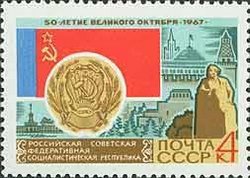Stamp: Russian Federation arms and flag (Soviet Union, USSR 1967)
Russian Federation arms and flag (Soviet Union, USSR 1967)
04 August (Soviet Union, USSR ) within release 50th Anniversary of Great October goes into circulation Stamp Russian Federation arms and flag face value 4 Russian kopek
| Stamp Russian Federation arms and flag in catalogues | |
|---|---|
| Michel: | Mi:SU 3372 |
Stamp is horizontal format.
Also in the issue 50th Anniversary of Great October:
- Stamp - Soviet arms and flag face value 4;
- Stamp - Armenian arms and flag face value 4;
- Stamp - Azerbaijan arms and flag face value 4;
- Stamp - Estonian arms and flag face value 4;
- Stamp - Georgian arms and flag face value 4;
- Stamp - Kazkh arms and flag face value 4;
- Stamp - Kirgisian arms and flag face value 4;
- Stamp - Latvian arms and flag face value 4;
- Stamp - Lithuanian arms and flag face value 4;
- Stamp - Moldovian arms and flag face value 4;
- Stamp - Russian Federation arms and flag face value 4;
- Stamp - Tadzhik arms and flag face value 4;
- Stamp - Turkmenian arms and flag face value 4;
- Stamp - Ukranian arms and flag face value 4;
- Stamp - Uzbek arms and flag face value 4;
Stamp Russian Federation arms and flag it reflects the thematic directions:
A flag is a piece of fabric (most often rectangular or quadrilateral) with a distinctive design that is used as a symbol, as a signaling device, or as decoration. The term flag is also used to refer to the graphic design employed, and flags have since evolved into a general tool for rudimentary signalling and identification, especially in environments where communication is similarly challenging (such as the maritime environment where semaphore is used). National flags are patriotic symbols with varied wide-ranging interpretations, often including strong military associations due to their original and ongoing military uses. Flags are also used in messaging, advertising, or for other decorative purposes. The study of flags is known as vexillology, from the Latin word vexillum, meaning flag or banner.
A monument is a type of structure that was explicitly created to commemorate a person or event, or which has become relevant to a social group as a part of their remembrance of historic times or cultural heritage, due to its artistic, historical, political, technical or architectural importance. Examples of monuments include statues, (war) memorials, historical buildings, archaeological sites, and cultural assets. If there is a public interest in its preservation, a monument can for example be listed as a UNESCO World Heritage Site. The Palgrave Encyclopedia of Cultural Heritage and Conflict gives the next definition of monument:
A coat of arms is an heraldic visual design on an escutcheon (i.e. shield), surcoat, or tabard. The coat of arms on an escutcheon forms the central element of the full heraldic achievement which in its whole consists of shield, supporters, crest, and motto. A coat of arms is traditionally unique to an individual person, family (except in the United Kingdom), state, organisation or corporation.



